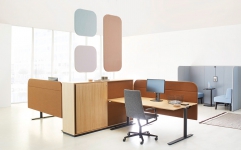New elements for ophelis docks
ophelis docks – islands in the office
ophelis docks, first introduced at the Orgatec 2012 and designed by Till Grosch and Björn Meier, is a modular system which can be combined to form different islands in the office that can function both as meeting point and interfaces, and as retreats where employees can concentrate or relax. The system consists of upholstered elements, modules such as e-boxes and bricks, as well as tables in sitting and standing height. Add-on panels can be used to integrate lamps and side tables into the configuration. The modules can be arranged individually on top of the base frame, providing a wide range of combination options. Elements can be combined to either screen acoustically and visually or create open meeting areas. Integrated cable channels provide electrification and network supply. The elements are matched in size with the ophelis furniture line to ensure the seamless connection and integration of shelves and accessory furniture.
New elements for ophelis docks
Till Grosch has designed new key elements for ophelis docks. Corner, diagonal, and armrest modules expand the range of configuration options. Various chairs and stools are used as mobile furniture that makes it possible to create open or semi-open suites of furniture in an even more flexible way. The new Highbench, which functions as a meeting point and a standing workplace, offers endless chaining and can be fully electrified. The compact version of docks makes it possible to create areas apart from the office islands. It is a perfect supplement for hallways, work and reception areas with limited floor space.
The modules, which will be introduced at Orgatec 2014, were created using the same design language as the docks system. Mobile seating furniture completes the existing islands. The ‘fixed’ configurations have an architectural quality, whereas the new chairs and stools can either be added flexible or used as stand-alone pieces.
docks is a shared piece of furniture
docks creates connections and transitions
docks provides an interface and a meeting point
docks offers a place for quiet concentration and relaxation
docks is a modular furniture systems for the office
docks creates islands in the office
DESIGNER STATEMENTS
“The office is not only a place to work; it is also a living space.”
“The trend towards open, decentralized office models represents a paradigm shift that can be observed on many levels in the working environment. We have positioned our design between the demand for an ongoing exchange of knowledge and ever-present communication and the need for privacy and areas for concentration.”
“By using the frame as a base construction we have given the furniture system its lightness. The mounted modules appear to float.”
“It was important for us to develop interfaces that allow the user to add different products. Lamps and side tables, for example, can be added by using the add-on panels. They can simply be indented into the slots to become an integral part of a furniture island.”
“The challenge in designing docks was to develop a highly flexible furniture system using a clear and distinct design language. Our focus was on designing modules that can be combined in countless ways but in combination they look like a cohesive piece of furniture.”
“We see docks as a mobile component of a constantly changing working environment. Its modular character allows it to evolve and adapt to the needs of a changing work culture.”
“Thanks to its high degree of variability docks facilitates unrestricted communication. The multifunctional furniture can be used to structure rooms and create versatile connections between different workspaces. At the same time, the modular design of the furniture system allows to expand or rearrange existing islands in an office.”
“The same design language that was used for the docks system was also applied to the new modules of 2014. Mobile seating furniture complete the islands. The ‘fixed’ arrangements have an architectural quality, whereas the new chairs and stools can either be added to different groupings for added flexibility or used as stand-alone pieces.”
“The compact version of docks can now also be used to furnish areas apart from the open space office. It is perfect for use in hallways, work and reception areas with limited floor space.”
*Design of the ‘ophelis docks’ system: 2012, Till Grosch and Björn Meier
Design of the ‘ophelis docks’ extensions: 2014, Till Grosch
Studio Grosch
www.studiogrosch.net







